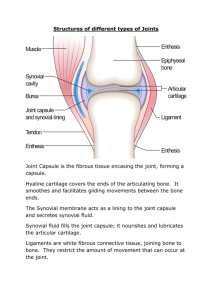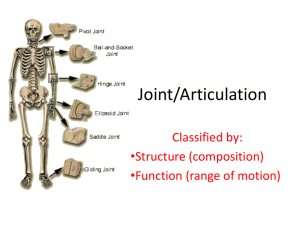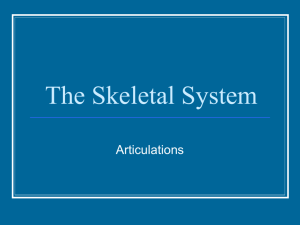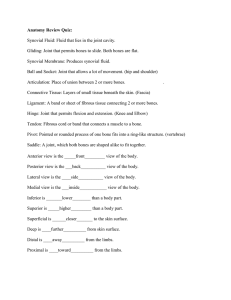Joints - Cloudfront.net
advertisement
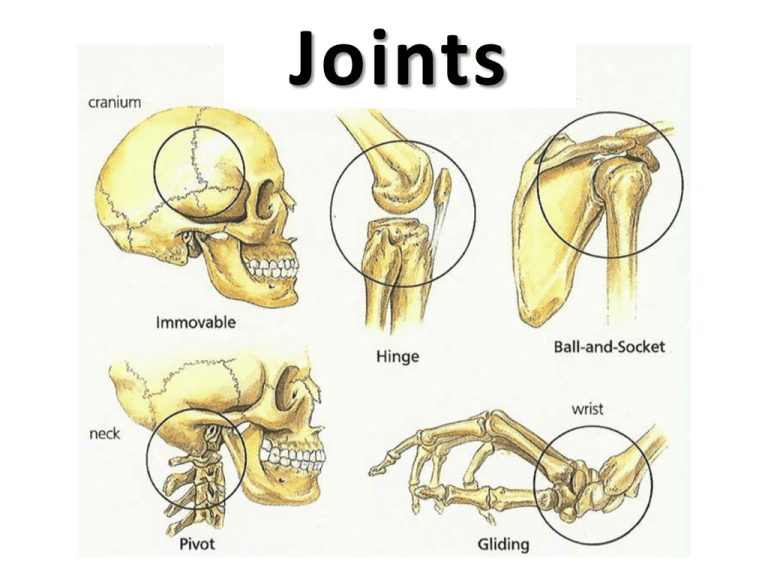
Joints Joints (articulation) • Defined: A point of contact between bones, between cartilage and bones, or between teeth and bones. – When two bones articulate with one another we say that the 2 bones form a joint. • Arthrology = study of joints • Kinesiology = study of movement within the human body • Rheumatology = study of joint diseases and related conditions Joint Strength, Flexibility, & Movement • Determined by: – Shape of the articulating bones – Flexibility of the ligaments that attach bone to bone – Tension of tendons and muscles of the articulating bones – Hormones • Dislocation: When articulating bones move from their normal positions. Joint Structure • Classification: – Type of connective tissue that holds the bones together. – The presence or absence of a synovial cavity (space between the articulating bones). Joint Function • Classification: – Relates to the amount of movement allowed • Types: – Synarthrosis = Immoveable joint • Ex. pelvis , sutures, teeth – Amphiarthrosis = Slightly moveable joint • Ex. epiphysis, tibia-fibula, vertebrae and pelvic symphysis – Diarthrosis = A freely movable joint. • All synovial joints fall into this category • Come in many shapes • Allow for different types of movements Types of Fibrous Joints • Fibrous joints are held together by fibrous connective tissue – bones lack a synovial cavity = little to no movement. 1. Suture • Unite the bones of the skull • The irregular interlocking edges decrease chances of fracturing • Functionally classified as Synarthrosis = Immovable Types of Fibrous Joints 2. Syndesmosis • Contains dense fibrous connective tissue • Functionally classified as amphiarthrosis = Slight movement • Ex. The distal articulation between the tibia and the fibula. Types of Fibrous Joints 3. Gomphosis • Cone shaped peg that fits into a socket • The only found in the articulations of the roots of the teeth with the sockets of the mandible & maxillae. • Functionally classified as synarthrosis = Immovable Types of Cartilaginous Joints • Cartilagious joints are held together by fibrocartilage or hyaline cartilage • Bones lack a synovial cavity 1. Synchondrosis • A cartilage joint that connects with hyaline cartilage • Ex. Epiphyseal plate that connect the epiphysis and the diaphysis of a bone. • Functionally classified as synarthrosis = Immovable Types of Cartilaginous Joints 1. Symphysis • A cartilage joint where ends of the articulating bones are covered with hyaline cartilage, but the bones themselves connect via fibrocartilage. • Ex. Pubic symphysis & between the bodies of vertebrae. • Functionally classified as amphiarthrosis = Slightly movable Types of Synovial Joints • Synovial joints – Presence of a synovial cavity – Functionally classified as diarthrosis = Freely movable – Epiphysis of bones are covered by articular (hyaline) cartilage – Reduces friction – Absorb shock – Contain ligaments: bundled fibers that connect bone to bone and give joints stability Types of Synovial Joints 1. Planar AKA Plane or Gliding Joint • Flat or slightly curved bones • Allow for side to side & back and forth gliding motion 2. Hinge Joint • Concave surface meets the convex surface of another bone • Allow for opening & closing motion like the hinge of a door Types of Synovial Joints 3. Pivot Joint • A rounded surface articulates with a ring formed by another bone or ligament. • Allows for rotation around its vertial axis. 4. Condyloid Joint • Convex-oval shape of one bone fits into the concaveoval shape of another. • Allows for up & down and side to side movement. Types of Synovial Joints 5. Saddle Joint • Allows for side to side and back to forth movement. 6. Ball & Socket Joint • Ball like surface of one bone fits into the cup like depression of another. • Allows for free movement. Joint Review Video (click picture)



